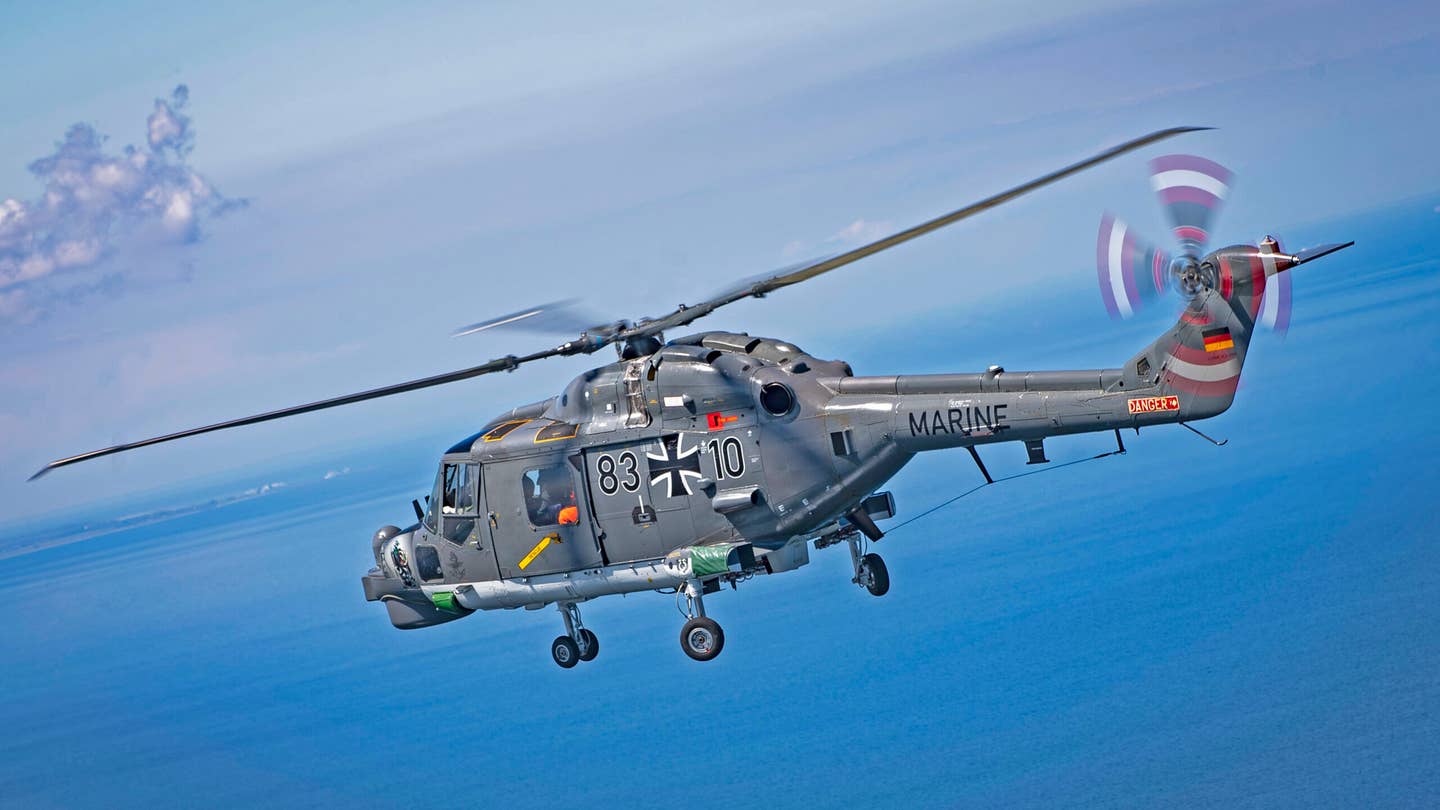German Navy Helicopter Destroys Houthi Drone Boat
The work of helicopters assigned to the multinational task forces protecting Red Sea shipping is being highlighted by recent Houthi drone kills

One day after a French Navy helicopter shot down a Houthi drone over the Red Sea, a German Navy helicopter has now successfully engaged one of the militants’ uncrewed surface vessels (USVs) in the same region. The incident reinforces the continued threat posed by Houthi drones and missiles of different kinds to shipping in the area, as well as the various different ways that the naval coalition has to defeat them.
According to the German Armed Forces’ Joint Forces Operational Command, the USV in question was destroyed by a helicopter launched from the Type 124 Sachsen class frigate Hessen. The warship is currently deployed as part of the Aspides mission, run by the European Union Naval Force (EUNAVFOR) and tasked with protecting commercial shipping in the Red Sea. According to the German military, the frigate “repelled an attack against a civilian convoy under tow in the Red Sea this morning. A surface drone was destroyed by the embarked helicopter. The Hessen is continuing its mission.”
No further details were provided about the type of USV that was destroyed, or exactly how it was engaged. However, Matthias Gebauer, a journalist for news magazine Der Spiegel, says that the USV “had already approached the convoy to within a few nautical miles, so speed was required.”
The description of a ship under tow (using the German word Schleppverband) suggests that the vessel targeted by the Houthis may have sustained prior damage, or a ship that was otherwise not able to move under its own power. It also suggests that Hessen may have been tasked with protecting that particular convoy when it came under attack.
The helicopter type involved wasn't specified, but the Hessen is known to have recently been operating with two embarked Sea Lynx Mk 88As. These multirole helicopters are typically armed with a single door-mounted 50-caliber heavy machine gun during these kinds of missions. In recent years, German Navy Sea Lynx have been repeatedly used for anti-piracy and boarding-party work.
While Houthi drones and missiles have been the most prominent targets of the naval task force in the Red Sea, there has also been a steady stream of USVs and uncrewed underwater vehicles (UUVs) to deal with.
Although past USV kills have not been attributed to particular assets, it's quite likely that embarked helicopters have previously been used to deal with these threats. Houthis pioneered the use of explosive-laden USVs, which were developed by their Iranian benefactors.
A video from January 2017 showing an explosive-laden Houthi USV striking a Saudi frigate:
As for the German Navy, we know that the Hessen has targeted Houthi drones in the air in at least one earlier incident. As we reported at the time, the Hessen downed two Houthi drones at close range while operating in the Red Sea late last month; the weapons used were the 76mm deck gun and the RIM-116 Rolling Airframe Missile (RAM). In addition, the ship accidentally fired on an American MQ-9 Reaper drone while confused as to its identity.
The Hessen arrived in the region only days ahead of these incidents, passing through the Suez Canal on February 24, after departing Germany on February 8.
Yesterday’s action involving a French Navy helicopter operating from one of its warships — possibly an AS565 Panther from the Aquitaine class frigate Alsace — demonstrated the utility of rotorcraft when it comes to shooting down drones in the air, again using their door guns.
However, targeting USVs is actually much more central to the naval helicopter’s mission spectrum.
In the case of the U.S. Navy, we have reported in the past on how its workhorse MH-60S/R Seahawk embarked helicopter units have increasingly embraced the mission of defending against potential attacks from swarms of small boats, in particular. USVs present a very similar threat class.
Both those U.S. Navy helicopters are well equipped for the task, having the option of being relatively heavily armed for force protection duties, including the ability to carry AGM-114 Hellfire missiles, M197 20mm Gatling guns, as well as 50-caliber guns and other crew-served weapons. In the latest Red Sea campaign, U.S. Navy MH-60R/S helicopters have also been used to destroy small crewed Houthi boats, as you can read about here.
The German Navy’s Sea Lynx Mk 88A does not have the same range of options when it comes to kinetic engagements of USVs, or other small waterborne craft, although, on this occasion its heavy machine gun was clearly up to the job. This is also a far less expensive application for this kind of target than the alternatives and provides some kind of standoff engagement capability.
Meanwhile, today has also seen the Red Sea task force deal with other kinds of Houthi threats, including three ballistic missiles that EUNAVOR says were successfully intercepted by a French warship.
Overall, there seems no chance of the Houthi threat to shipping letting up any time soon, although the Yemen-based militants have now come to an agreement with China and Russia to ensure that their vessels don’t come under attack. This understanding on safe passage was reached during talks in Oman.
As previously mentioned, it’s very likely that earlier engagements of Houthi drones involved gun-armed helicopters and, as the Red Sea campaign continues, there are almost certain to be more such incidents to come.
Contact the author: thomas@thewarzone.com


